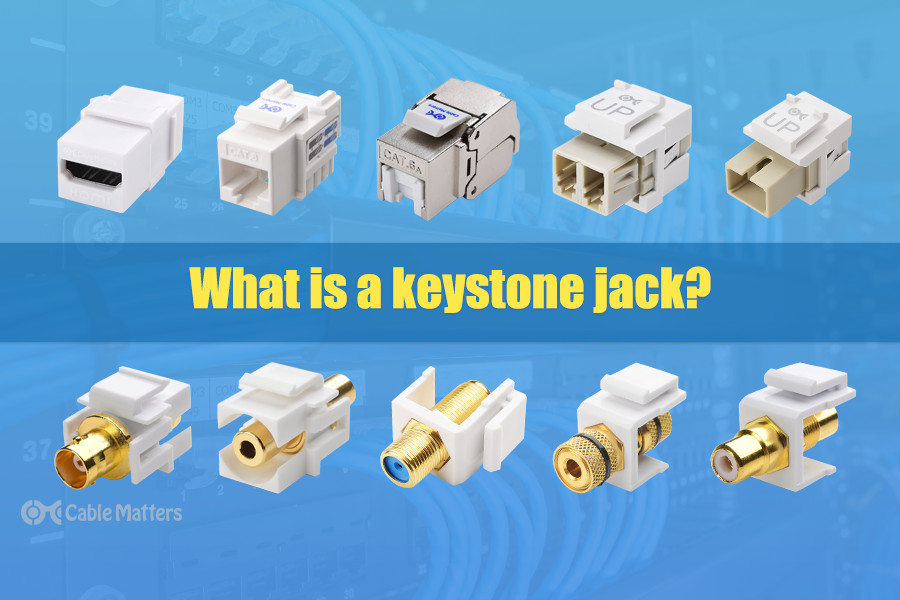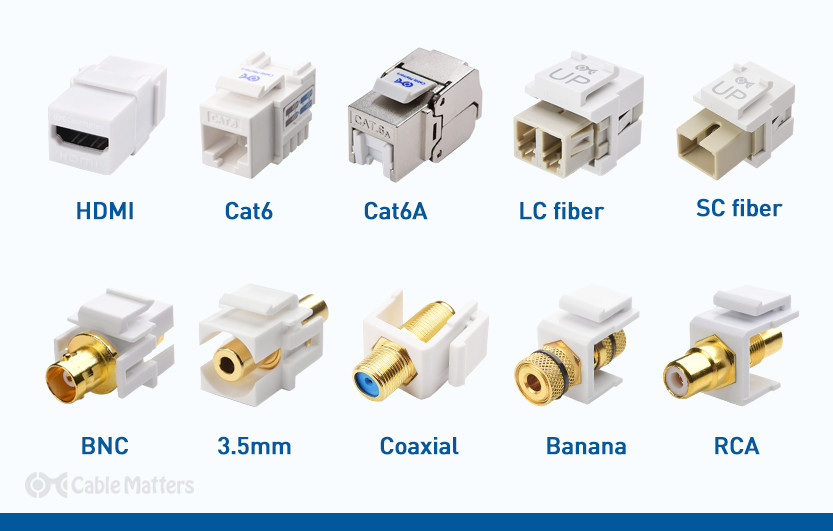
Keystone jacks are an important component in expansive local area networks that make use of patch panels and wall plates. It’s a female connector for connecting different types to the wider network that are designed to snap in to modular wall plates and patch panels. The name comes from them looking like an architectural keystone, and they improve the versatility of patch panels by giving administrators fine control over the types of connections that are used in modular patch panels for more varied network connections.
Are all keystone jacks the same?
No. There are a number of different connection options for keystone jacks, enabling a wide range of supported options in modular wall plates and patch panels, but to make them fit a wide range of those panels, most keystone jacks do share a physical size and shape.
Keystone jacks typically have a rectangular face measuring 14.5 x 16mm, and have flexible tabs to hold them in place and allow them to physically snap into compatible patch panels. This makes keystone jacks almost universally replaceable and interchangeable, as well as reusable, making it possible to manage modular patch panels and wall mounts down to the individual port and connector.
Some keystone jacks feature a pass-through connector, where the same port is found on the front and back, while others feature a female connector on one side, and a male on the other. Others still, have a standard port on the front, with a system for hard-wiring cables on the rear, such as punch down blocks. Others allow for soldering or crimped connections.
What are the different types of keystone jack?
Although keystone jacks are primarily used to offer RJ45 Ethernet connectivity, there are a wide array of different connection options for compatible patch panels. They include standard patch panel offerings like RJ45 Ethernet (with various speed and shielding support), as well as coaxial, and fiber optic connections. However, they can, in theory, offer almost any kind of connection possible.
Cable Matters offers a wide range of less common keystone jacks, including HDMI 2.1 keystone jacks with 8K and 4K 120Hz support, as well as blank keystone jacks which are used to block off unused ports on wall jacks and patch panels. There are also RCA jacks, speaker terminals, 3.5mm TRS connectors, 8P8C modular jacks, and 6P6C RJ11 modular jacks, among others.

There’s a lot of variation in keystone jacks in terms of features and specifications, too. Some come with gold-plated connectors for improved anti-corrosion resistance, while others come in a range of colors to better differentiate between them when installed.
Ethernet RJ45 keystone jacks can also come rated for different speeds in line with Ethernet cable category ratings, with some of the more recent releases offering up to 10 Gigabit Ethernet support for Cat 6a cabling and beyond. Those rated for higher performance will also typically use thicker copper wiring and have improved per-wire shielding for reduced signal degradation and added protection against crosstalk.
Cable Matters also includes a free punch down stand with its larger packs of RJ45 keystone jacks (they can also be purchased separately), making the punching down process that bit easier. A punch down tool is still recommended, however.
When buying a keystone jack, it’s also important to look out for signs of high-quality manufacturing, such as the use of fire retardant plastic, dust caps for improved cable strain relief, and impact resistant construction standards.
Where are keystone jacks used?
Keystone jacks are designed to be used in keystone wall plates, surface mount boxes, and keystone patch panels. These are sometimes sold as blank patch panels, making it clear that you need to add your own keystone jacks to give you the same functionality as standard patch panels which come with pre-fitted, or non-modular connectors.
Most blank or keystone panels feature universal sizing, so will take most types of keystone jacks, although slimline patch panels may require bespoke keystone jacks designed to offer a trimmer profile.
When buying a patch panel or wall mount for your keystone jacks, be sure to check their compatibility with the types that you want to use and look out for marks of quality like cable strain relief and labeling spaces on the front and back to make it easier to distinguish between cables and connections, as well as identify their roles.
If you’re planning to mount your keystone patch panel in a rack mount or particular wall space, then be sure that it supports the size of rack you have, or that its dimensions adhere to the shape and size of your wall mount space. Some mounting hardware for keystone patch panels is sold separately, too, so be sure yours includes it, or you make that additional purchase if necessary.